

The Four Indian Kings
Peter Schuyler, a former mayor of Albany, a well to do fur trader, and a member of the New York Indian Commission; took five Mohawk chiefs, of the Five Nations of the Iroquois, to London, England in 1710. Schuyler wanted them to ask for assistance against their French enemies. This was a purely political move for Schuyler. Aid from the motherland (England) would greatly improve his position in the colonies. The Iroquois held Schuyler in high regard. He was their special intermediary with the colonial government. One of the five original chiefs died on the ship before he could reach London. The other four had their portraits painted by artist Jan Verelst, an obscure Dutch artist. Jan Verelst was only one of the three artists employed for this job. Veresldt painted the chiefs as if they were European nobility. In each portrait they hold an object denoting their status. These paintings were housed in Kensington Palace, Queen Anne's London home. The Mohawks made a sensation all dressed in exotic apparel. The red cloaks were made for the chiefs upon their arrival and were gifts from Queen Anne. Queen Anne commissioned Jan Veresldt to paint these men in 1710, to commemorate their visit. The Veresldt paintings featured the chiefs each with its own hereditary clan animal at their side. These portraits are now housed in the Canadian
British Nobility. Many nobles competed for the privilege of entertaining these "Four Indian Kings" as they were called.
It was said that the kings were almost two meters tall and had an imposing bearing and splendid physiques. The British court was still mourning the death of Prince George of Denmark, Queen Anne's husband and King. The Kings wore black breeches, vests, and stockings and over this they wore a scarlet cloak trimmed with gold (in the Bernard Lens version).
The Four Kings visited the Tower of London and Saint Paul's Cathedral. They attended cockfights, bear fights, and wrestling matches. They even saw a Shakespearean play (MacBeth) at the Haymarket Theatre.
They had an audience with Queen Ann (reigned from 1702-1714), successor of William III and her sister, Mary II. The queen ordered the construction of a new fort and chapel, called Fort Hunter, along the Mohawk River. Queen Anne provided missionaries from the Church of England and she patronized the Mohawk mission. The missionaries devised a system of writing in the Mohawk language and religious literature was translated into Mohawk. Cheif Hendrick was said to one of the most faithful. In 1755, Hendrick was 70 years of age when he took 300 warriors to fight against the French alongside the English. He died in 1755, at age 70, at a battle site near Lake George in the Adirondacks.
Jan Verelst' Paintings:
Written and researched by Margaret Knight Sypniewska, B.F.A.
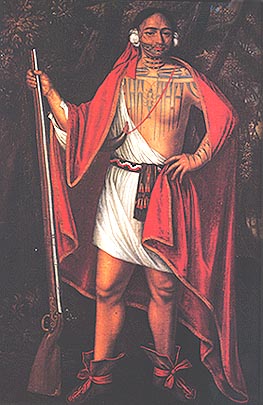 .....
..... 
Left is "Sa Ga Yeath Qua Pieth Tow" (1710) of the Bear clan, labelled "King of Maguas." He was the grandfather of Joseph Brant. Joseph's grandfather was Catholic. Sagayeathquapiethtow son's name was Tehowaghwengaraghkwin ("a man taking off his snowshoes"), whose Christian name was Peter Brant. Peter was the hereditary Tekarihoga, the leading sachem of the Mohawks. He is shown holding a musket. Brant died shortly before returning to America. He is is depicted with elaborate tatoos.
On the right is "Ho Nee Yeath Taw No Row" or John of Canojaharie ("Great Boiling Pot") of the wolf clan (1710). He is shown holding a bow while a quiver of arrows is on the ground, and is labelled as "King of Canojaharie." Canajoharie was located on the south side of the Mohawk River, thirty miles upstream from the lower castle called Tionderoga, which was located next to Fort Hunter.
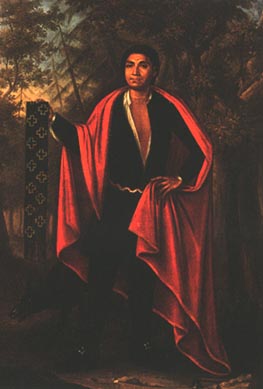 .....
.....
"Tee Yee Ho Ga Row" (1710) meaning "Double Life" of the wolf clan is shown holding a wampum belt. He was also known as King Hendrick (1680-1755), or Hendrick Peters, a Mahican-Mohawk leader. He advanced to leadership among the Mohawks after his adoption into the Wolf Clan. There were Mahicans living among the Mohawks. King Hendrick was a Christian and he was said to have been over six feet tall.
Right is "Etow Ch Koam" or Nicholas. He was a Mahican of the Turtle clan, and is holding a ball-headed war club and an English dress sword. This portrait is labelled "Emperor of the Six Nations" of the Upper Hudson River Valley.
Bernard Lens (III) (1682-1740):
Bernard Lens was an English artist, miniaturist, topographical draughtsman; etcher, limner, and drawing master. The "Portraits of the Four Mohawk Kings" (below) were also thought to be done by Bernard Lens. These portraits are housed in the British Museum Collection:
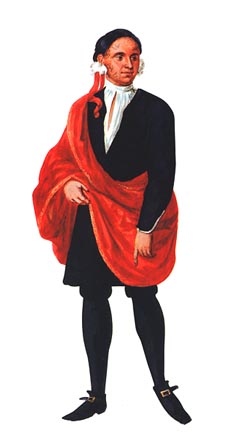 .....
..... 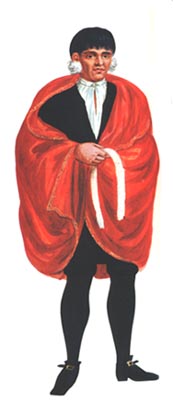 .....
..... 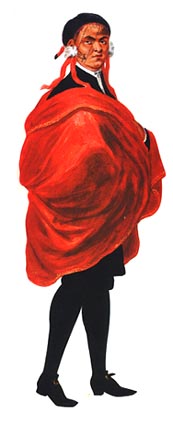
A third set of paintings were held by the Hudson Bay Company in Winnipeg, Canada. These were done after those shown above, sometime around 1755. I do not presently know the name of the third painter that was hired by Queen Anne. Perhaps they were stolen or sold?.
More on Famous Iroquois Chiefs:
*Joseph Brant (Thayendanagea) ... Joseph Brant ... Hiawatha (Mohawk), the Unifier
Red Jacket (Seneca Chief) ... Handsome Lake (Seneca Chief ... Cornplanter
King Hendrick (Mohawk Chief) ... John Brant
SOURCES:
Deloria, Jr., Vine and William Sturtevant were Consultants. World of the American Indian. Washington, D.C.: National Geographic Society, 1993.
Josephy, Jr., Alvin M. 500 Nations. New York: Alfred A. Knopf, 1994.
This page was last updated on December 3, 2017
